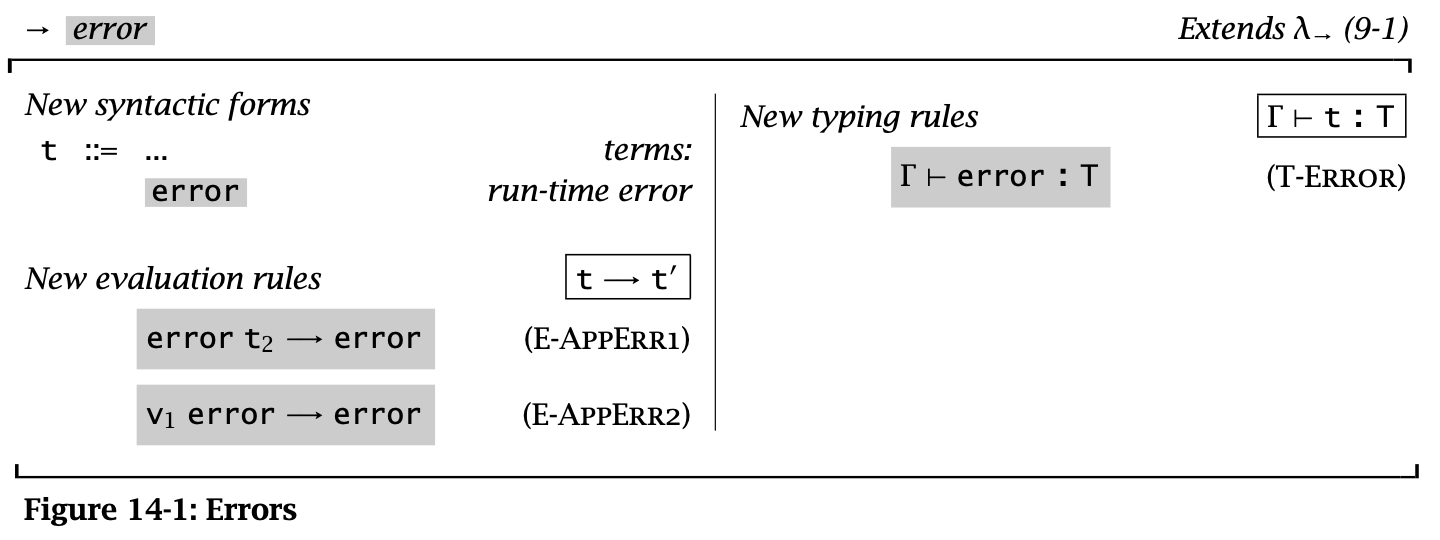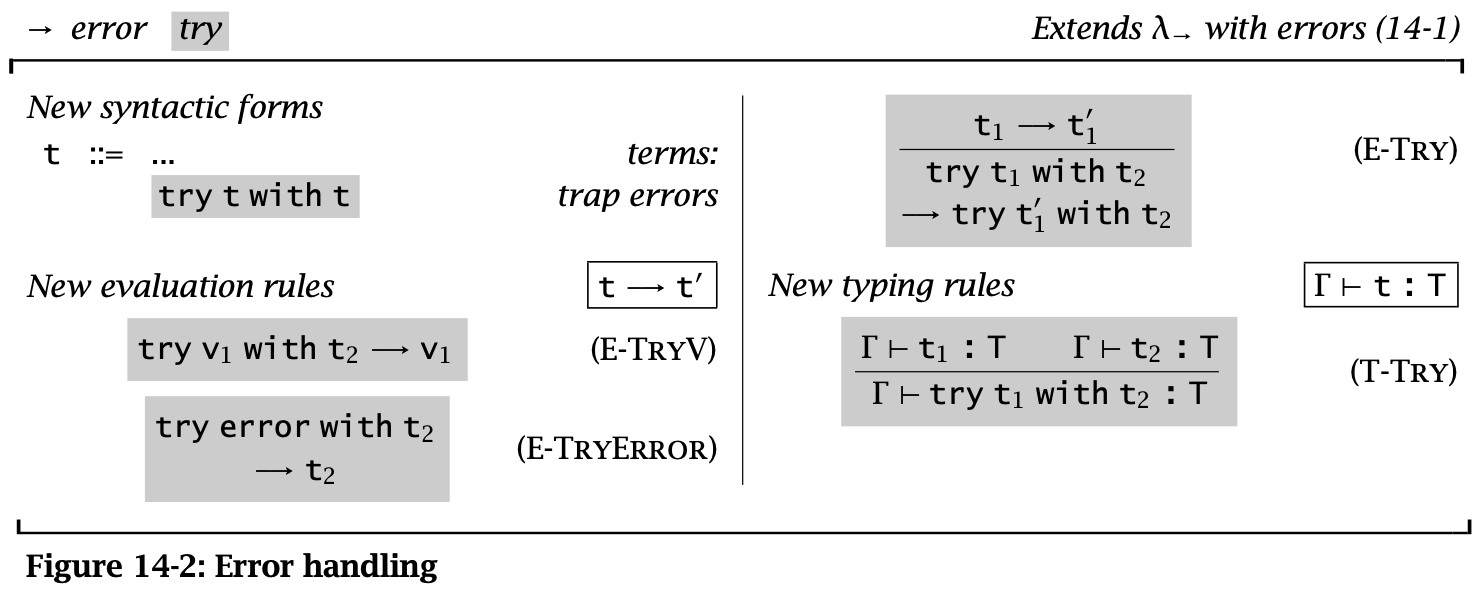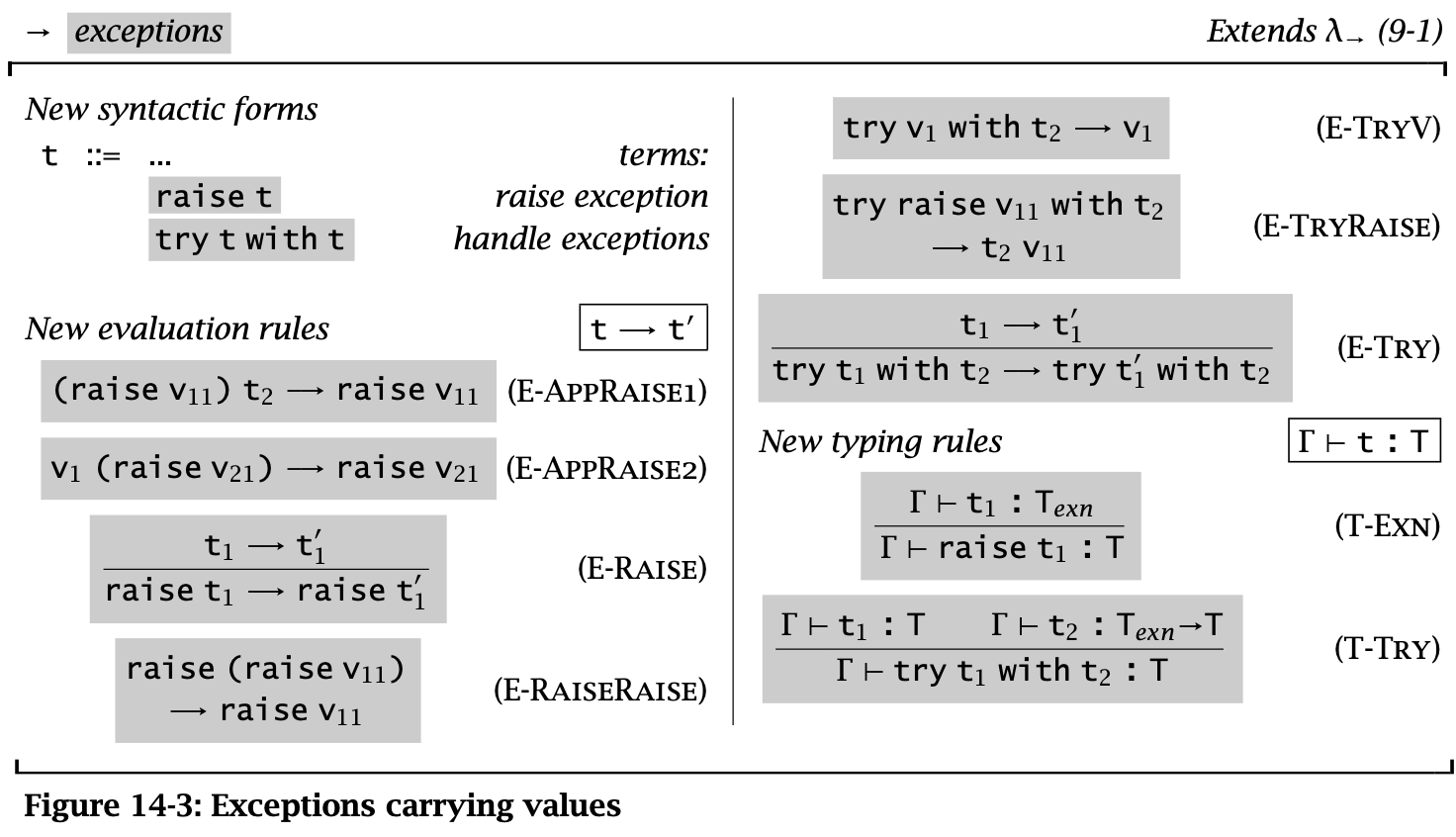程序在运行过程中会发生各种异常情况,此时可以通过 Optional 类型去处理,但是这种方式要求每个 caller 都要参与到错误的处理中。而使用异常机制则可以直接将 exceptions 交给 exceptions handler 处理(此时程序的 control flow 发生变化),或者直接终止程序。
本章基于 STLC 和一些扩展类型,并且分成三类讨论:遇到异常直接终止程序、将异常移交 handler 处理以及将异常信息传递给 handler。
Raising Exceptions

Figure 1: Errors
首先定义 error,其 evaluation rules 使得程序只要一遇到 error 就会退出。
这里只把 error 定义为 term 而不是 value,这样消除了规则调用的二义性。如果 error 是 value 的话,那么对于 \((\lambda x : \operatorname{\mathtt{Nat}}. 0)\ \operatorname{\mathtt{error}}\) 既可以调用 E-AppAbs 又可以调用 E-AppErr2。同样 E-AppErr2 也要求左侧为 \(v_1\),防止有二义性。
在加了 exceptions 类型后,preservation property 和原来一样(即 evaluation 不改变类型),但是 progress property 会发生变化(因为加入了 error,结果不一定再是 value)。
(Progress)
Suppose \(t\) is a closed, well-typed normal form. Then either \(t\) is a value or \(t=\operatorname{\mathtt{error}}\).
Syntax-directed
(Syntax-directed)
符合 syntax directed 的规则需要满足两点要求:
- 规则使用没有二义性(对于一个 term 只能使用一种规则,不会出现两种规则可以同时用于一个 term 的情况)
- 通过语法就可以进行推断(例如类型推断 \(t_1\ t_2\) 只需要知道二者的类型就可以知道这个 term 的类型)
\[ \Gamma \vdash \operatorname{\mathtt{error}} : T \]
上面这条规则使得 evaluation rules 不再是 syntax directed 的了,并导致了 uniqueness of types theorem 失效。T-Error 表明 error 可以是任何类型。例如在 \((\lambda x : \operatorname{\mathtt{Bool}}. x)(\operatorname{\mathtt{error}}\ \operatorname{\mathtt{true}})\) 中 error 的类型为 \(\operatorname{\mathtt{Bool}} \rightarrow \operatorname{\mathtt{Bool}}\)。但是 T-Error 这个打破了“所有 term 都只有一个类型”的规则,这一点会在后面解决:
- 在支持 subtyping 的系统中,可以令 \(\operatorname{\mathtt{error}} : \bot\)
- 在支持 parametric polymorphism 的系统中,可以令 \(\operatorname{\mathtt{error}} : \forall x. x\)
能否通过手动给 error 标注类型来解决问题?
error 不能是某个具体的类型(即不能通过 ascription 的手段去解决 exceptions 的问题),必须是 \(T\),否则会违反 preservation 性质。因为在传递 error 的过程中,error 的类型会随着上下文的改变而发生改变。
例如在 \((\lambda x : \operatorname{\mathtt{Nat}}. x) ((\lambda y : \operatorname{\mathtt{Bool}}. 5) (\operatorname{\mathtt{error}}\ \operatorname{\mathtt{as}}\ \operatorname{\mathtt{Bool}}));\) 中,进行外部函数的规约时就会发生错误。
Handling Exceptions

Figure 2: Error Handling
error 求值的过程中会 unwinding call stack 并直接返回。Call stack 由 activation records 组成,其中每个 record 都是一个函数调用。Exceptions 传播的过程就是 activation records 从栈中弹出的过程。在 error 向上传播的过程中可以用 error handler 来捕获异常。此时的 exceptions 在传播时,会不断弹出 call stack 中的 activation records,直到遇到最近的 error handler,然后执行 handler。
这里用 \(\operatorname{\mathtt{try}}\ t_1\ \operatorname{\mathtt{with}}\ t_2\) 来表示 error handler,一旦遇到 error 就执行 \(t_2\)。显然 \(t_1\) 和 \(t_2\) 的类型必须相同。
Exceptions Carrying Values

Figure 3: Exceptions carrying values
发生异常时可以携带一些信息,包括异常类型等。这里用 \(\operatorname{\mathtt{raise}} \operatorname{\mathtt{t}}\) 来代替普通的 error 引发异常,其中 raise 可以当作一个 constructor,\(t : T_{exn}\) 是其携带的信息,\(\operatorname{\mathtt{raise}} \operatorname{\mathtt{t}} : T\) 的类型类似于 error,便于嵌入表达式的任何位置。
引发异常后可以用 \(\operatorname{\mathtt{try}}\ \operatorname{\mathtt{with}}\)(E-TryRaise)语句来处理异常。E-RaiseRaise 用于处理嵌套的异常。E-TryV 则表明没有发生异常。
所携带的信息 \(T_{exn}\) 可以有很多情况:
Nat,即作为errno错误号,但是需要查表得到错误信息String,即错误相关的信息,但是需要进行 parsevariant type,其中每种case还能携带额外的信息,但是只能抛出事先规定的几种异常extensible variant type(ML 的做法),可以使用exception l of T实时扩展异常类型exn,使得 \(T_{exn}\langle l_1 : T_1 \dots l_n : t_n, l : T \rangle\):\[ \operatorname{\mathtt{raise}}\ l(t) \overset{\text{def}}{=} \operatorname{\mathtt{raise}}\ (\langle l = t \rangle\ \operatorname{\mathtt{as}}\ T_{exn}) \]
\begin{aligned} \operatorname{\mathtt{raise}}\ t\ \operatorname{\mathtt{with}}\ l(x) \overset{\text{def}}{=} &\operatorname{\mathtt{try}}\ t\ \operatorname{\mathtt{with}} \\ &\quad \lambda e : T_{exn}. \operatorname{\mathtt{case}}\ e\ \operatorname{\mathtt{of}} \\ &\qquad\ \langle l = x \rangle \Rightarrow h \\ &\qquad \vert\ \_ \Rightarrow \operatorname{\mathtt{raise}}\ e \end{aligned}
Java 使用
class来表示异常,其中异常相关的类需要继承自Throwable。因此 Java 的异常类之间可以有继承关系(而 ML 中的异常都是平级的)。并且在 Java 中还区分了Exceptions和Errors,前者可以被捕获处理,而后者会终止程序。Java 的另一个特殊点在于它是 checked exceptions,即方法抛出的异常是方法签名的一部分,并且方法调用者必须要处理方法中的所有异常。
Exceptions as a control flow
Exceptions 不仅仅是一种错误处理机制,同时还代表了一种控制流结构:
- A way to quickly escape from the computation
- Handler
- Value-carrying
- A single type \(T_{exn}\) shared all exception handler
在 OCaml 中,exceptions 不仅仅用于异常处理,还被用作控制程序的执行。
Continuations
类似 exceptions,continuations 也可以用这样的方法建立类型。